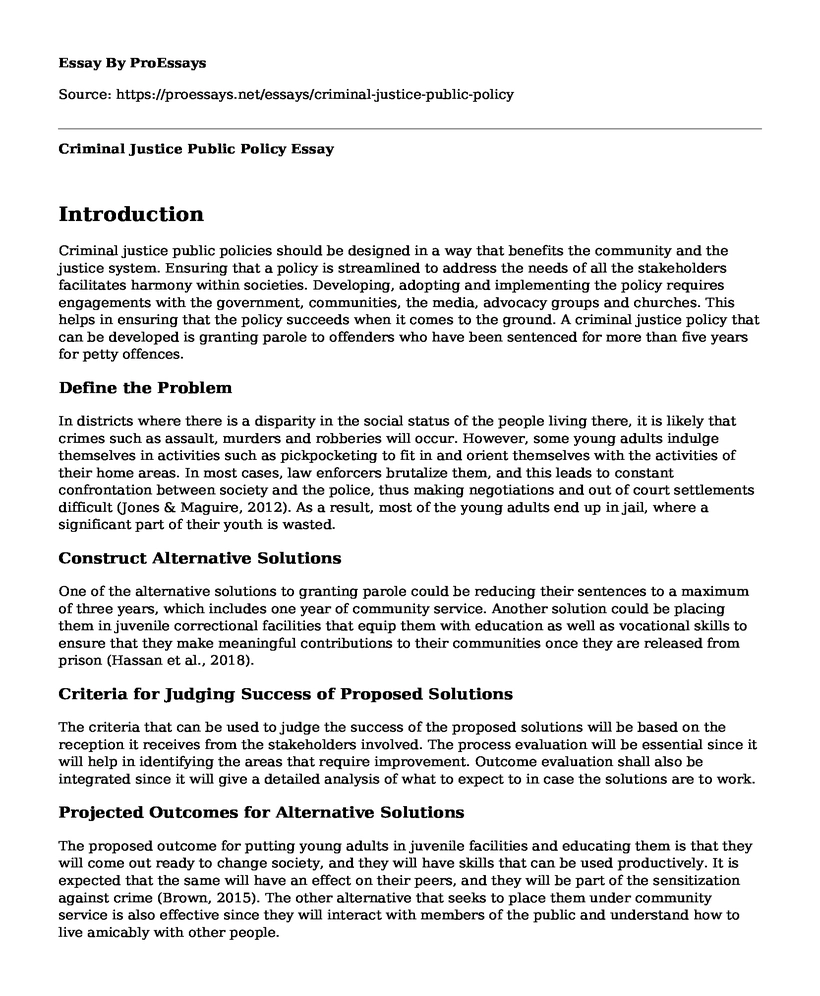Introduction
Criminal justice public policies should be designed in a way that benefits the community and the justice system. Ensuring that a policy is streamlined to address the needs of all the stakeholders facilitates harmony within societies. Developing, adopting and implementing the policy requires engagements with the government, communities, the media, advocacy groups and churches. This helps in ensuring that the policy succeeds when it comes to the ground. A criminal justice policy that can be developed is granting parole to offenders who have been sentenced for more than five years for petty offences.
Define the Problem
In districts where there is a disparity in the social status of the people living there, it is likely that crimes such as assault, murders and robberies will occur. However, some young adults indulge themselves in activities such as pickpocketing to fit in and orient themselves with the activities of their home areas. In most cases, law enforcers brutalize them, and this leads to constant confrontation between society and the police, thus making negotiations and out of court settlements difficult (Jones & Maguire, 2012). As a result, most of the young adults end up in jail, where a significant part of their youth is wasted.
Construct Alternative Solutions
One of the alternative solutions to granting parole could be reducing their sentences to a maximum of three years, which includes one year of community service. Another solution could be placing them in juvenile correctional facilities that equip them with education as well as vocational skills to ensure that they make meaningful contributions to their communities once they are released from prison (Hassan et al., 2018).
Criteria for Judging Success of Proposed Solutions
The criteria that can be used to judge the success of the proposed solutions will be based on the reception it receives from the stakeholders involved. The process evaluation will be essential since it will help in identifying the areas that require improvement. Outcome evaluation shall also be integrated since it will give a detailed analysis of what to expect to in case the solutions are to work.
Projected Outcomes for Alternative Solutions
The proposed outcome for putting young adults in juvenile facilities and educating them is that they will come out ready to change society, and they will have skills that can be used productively. It is expected that the same will have an effect on their peers, and they will be part of the sensitization against crime (Brown, 2015). The other alternative that seeks to place them under community service is also effective since they will interact with members of the public and understand how to live amicably with other people.
Analyze Trade-Offs for Solutions
One of the trade-offs that can be utilized is forfeiting the one year in community service and ensuring that they serve a full sentence in prison.
Choose Best Solutions
In this case, the best solution would be to ensure that the government invests in equipping prisoners with transferrable skills and vocational training to ensure that they become active members of the societies they will be part of after serving their sentences (Jannetta & Okeke, 2017). This solution is also effective since it will help people discover their abilities while in prison through the guidance of the professionals in the institutions.
Explain Recommendations
These solutions are effective since they create room for dialogue, and they open up the community to seeing that there is a second chance for offenders. They also help in showing that prisons, when utilized as correctional facilities and not punishment centres, can change people for the betterment of society.
References
Brown, S. A. (2015). Trends in juvenile justice state legislation 2011-2015. National Conference of State Legislatures.
Hassan, M. S., Mahbob, M. H., Rahim, M., & Abd, H. (2018). Analysis Informal Social Control Scale toward Integrity Value of the Young People. International Journal of Academic Research in Business and Social Sciences, 8(6), 181-201.
Jannetta, J., & Okeke, C. (2017). Strategies for Reducing Criminal and Juvenile Justice Involvement. Building Ladders of Opportunity for Young People in the Great Lakes States, brief, 4.
Jones, T., & Maguire, M. (2012). Crime, community safety and the policing of marginalized populations: a review of research.
Cite this page
Criminal Justice Public Policy. (2022, Feb 22). Retrieved from https://proessays.net/essays/criminal-justice-public-policy
If you are the original author of this essay and no longer wish to have it published on the ProEssays website, please click below to request its removal:
- Do Background Checks Actually Work to Deter Crime? - Essay Sample
- Rhetorical Essay on Speech "The Ballot or the Bullet"
- Citation Activity on The Rich Get Richer, and the Poor Get Robbed: Inequality in U.S. Criminal Victimization
- Diversion Programs Essay Example
- Research Paper on Effects of Stand Your Ground Laws: Increase in Violence & Deaths
- Essay Example on God Bless the Child: US Response to Juvenile Prostitution
- Data Security and Privacy Protection in Cloud Computing - Research Paper







